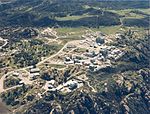Brandeis-Bardin Institute
1941 establishments in the United States1947 establishments in CaliforniaAmerican Jewish UniversityEducation in Simi Valley, CaliforniaJewish organizations established in 1941 ... and 6 more
Jewish organizations established in 1947Jewish summer camps in CaliforniaJews and Judaism in Los AngelesSimi HillsUniversities and colleges in Ventura County, CaliforniaVague or ambiguous time from February 2011
The Brandeis-Bardin Campus of American Jewish University is a Jewish retreat located since 1947 in the northeastern Simi Hills, in the city of Simi Valley, California. Formerly known as the Brandeis-Bardin Institute, it is used for nondenominational summer programs for children, teens, and young adults.
Excerpt from the Wikipedia article Brandeis-Bardin Institute (License: CC BY-SA 3.0, Authors).Brandeis-Bardin Institute
Arness Road, Simi Valley
Geographical coordinates (GPS) Address Nearby Places Show on map
Geographical coordinates (GPS)
| Latitude | Longitude |
|---|---|
| N 34.25954 ° | E -118.713166 ° |
Address
Brandeis-Bardin Campus (American Jewish University)
Arness Road 1101
93064 Simi Valley
California, United States
Open on Google Maps








